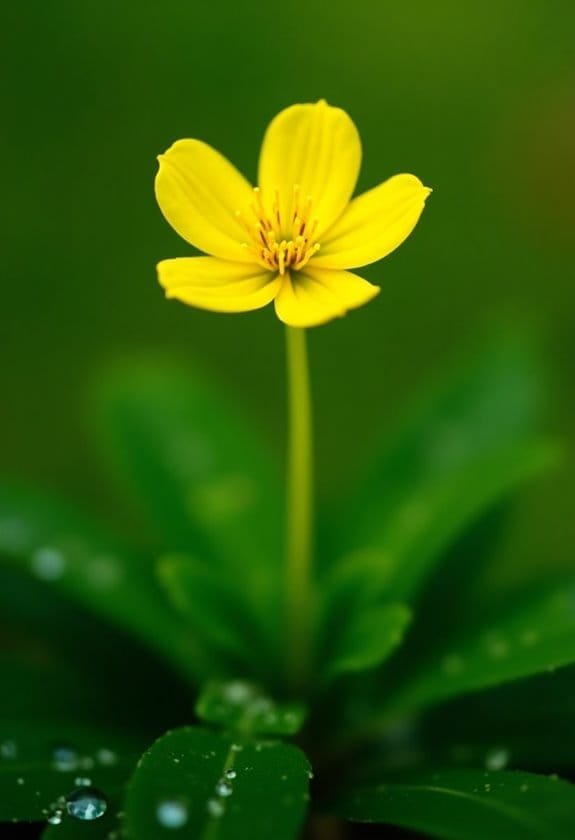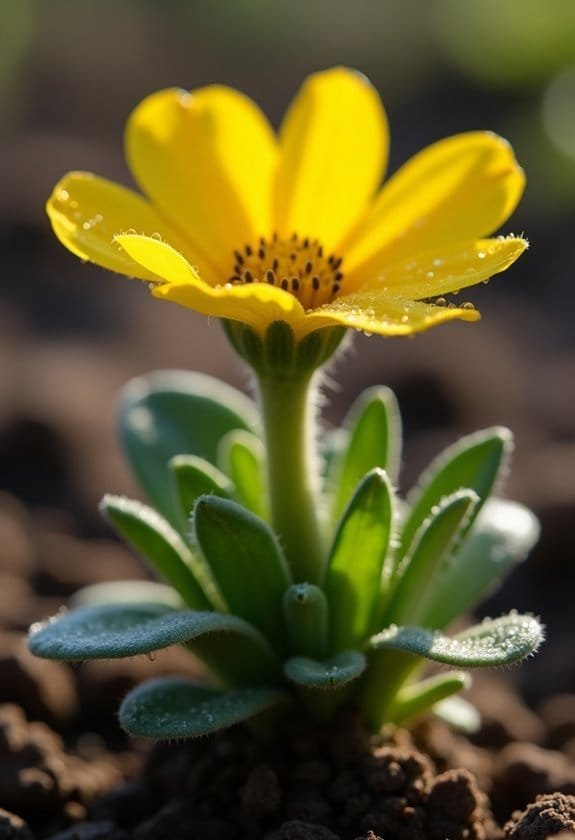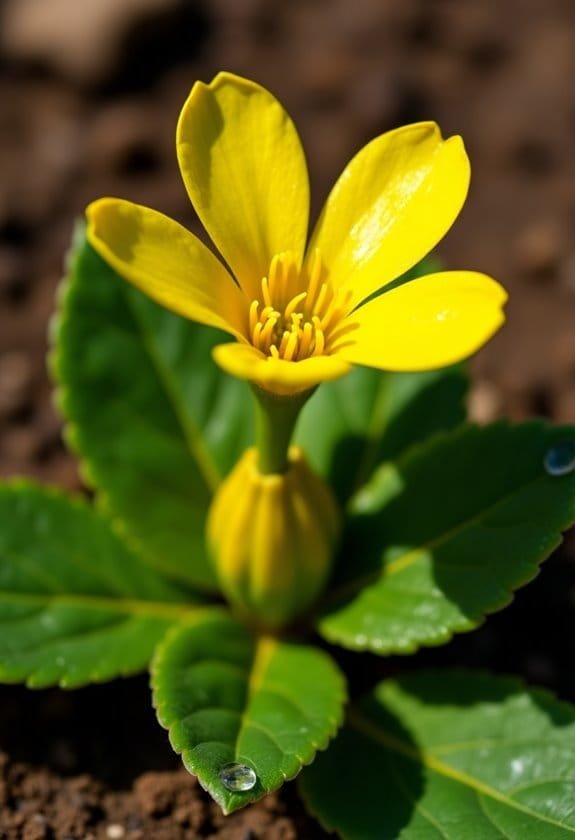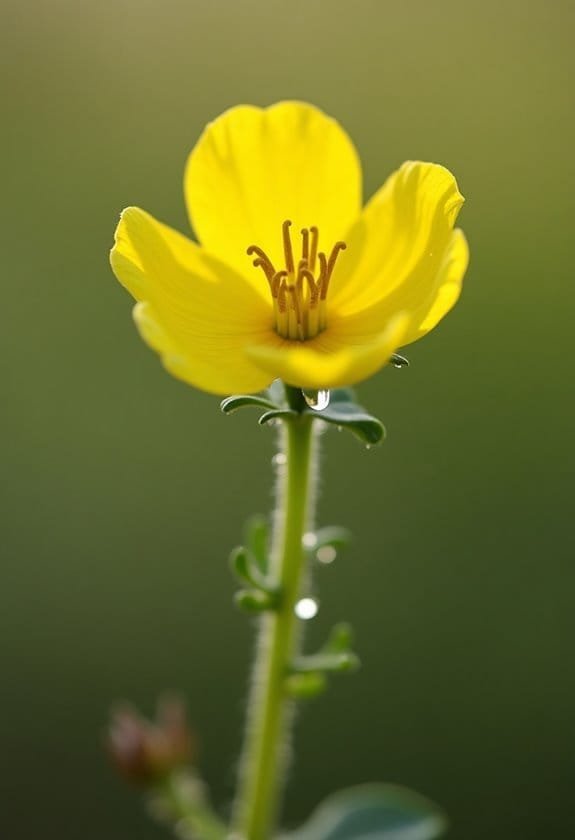Bulbous buttercup (Ranunculus bulbosus) is a perennial flowering plant that grows 20-60 centimeters tall, featuring distinctive swollen stem bases and bright yellow flowers. It thrives in well-drained soils and temperatures between 60-75°F, attracting various pollinators including bees and hover flies. While it's valued for supporting early-season pollinator populations, it's also notorious as an aggressive weed that can spread rapidly through both seeds and vegetative reproduction. The plant's historical significance includes medieval nicknames like "frogsfoot" and its role in old English folklore about milk production. Understanding this species' complex nature reveals fascinating insights about its ecological impact and management strategies.
Main Points
- Bulbous buttercup is a perennial wildflower characterized by bright yellow flowers and a distinctive swollen stem base for nutrient storage.
- Named and classified by Carl Linnaeus in 1753, it belongs to the Ranunculaceae family and grows 20-60 centimeters tall.
- The plant thrives in well-drained soils with full sun to partial shade, requiring regular watering during its growth period.
- All parts are toxic, causing severe inflammation and blistering when touched or ingested by humans and livestock.
- Considered an aggressive weed in many regions, control requires complete removal of bulb and roots to prevent regeneration.
Introduction

Bulbous Buttercup (Ranunculus bulbosus) is a flowering plant species found abundantly across meadows, pastures, and grassy areas throughout Europe and North America.
The plant gets its common name from its distinctive swollen stem base, which forms a bulb-like structure just below the soil surface.
As a member of the buttercup family (Ranunculaceae), this herbaceous perennial displays the characteristic glossy yellow flowers and deeply divided leaves that have made buttercups recognizable worldwide.
Common Name
The common name "bulbous buttercup" stems from the plant's swollen stem base and its bright yellow buttercup flowers. This distinctive name helps distinguish it from other buttercup species in the Ranunculus family, where it's known scientifically as Ranunculus bulbosus.
Throughout history, the plant's common name has carried cautionary undertones, as its toxicity makes it dangerous to livestock and humans. While some traditional herbalists once used bulbous buttercup for treating various ailments, its caustic properties can cause severe inflammation and blistering of the skin.
In medieval Europe, the plant earned colorful nicknames like "frogsfoot" and "golden knobs," referencing both its habitat preferences and characteristic bulbous base.
The name "buttercup" itself originates from an old English folk belief that the flower's yellow reflection under a cow's chin indicated the richness of its milk production.
Today, the common name serves as a familiar reference point for botanists and gardeners alike, though they're careful to note its status as an aggressive weed in many regions.
Scientific Name
Originally classified in 1753 by Carl Linnaeus, Ranunculus bulbosus belongs to the buttercup family Ranunculaceae. The genus name Ranunculus derives from the Latin word "rana," meaning frog, referencing these plants' preference for moist habitats where frogs are commonly found. The species epithet "bulbosus" describes the distinctive bulb-like swelling at the plant's base, which serves as an essential identifying characteristic in taxonomy classification.
Within the botanical hierarchy, R. bulbosus maintains significant botanical significance as one of approximately 600 species in the Ranunculus genus. The plant's scientific nomenclature follows the standardized binomial system, which Linnaeus himself established as the foundation of modern plant taxonomy.
This systematic classification helps botanists and researchers worldwide accurately identify and study the species, distinguishing it from similar-looking relatives like R. acris and R. repens.
The scientific name's precision has proven invaluable in documenting the plant's distribution patterns, genetic variations, and evolutionary relationships within the Ranunculaceae family, contributing to our understanding of buttercup diversity across different geographical regions and ecological niches.
Overview
Known throughout Europe and North America, Ranunculus bulbosus stands as a perennial flowering plant distinguished by its bright yellow petals and distinctive bulbous base. This hardy species, which typically grows to heights between 20-60 centimeters, has adapted to thrive in various grassland habitats, from meadows to pastures.
The plant plays a crucial ecological role in supporting pollinators, particularly early-emerging bees and butterflies that depend on its nectar-rich flowers during spring blooming periods. While historically valued for certain medicinal uses, modern research has shown that the plant contains ranunculin, a compound that converts to protoanemonin upon tissue damage, making it toxic to livestock and humans if ingested.
The bulbous buttercup's success as a species can be attributed to its remarkable reproductive strategies, combining both seed dispersal and vegetative propagation through its characteristic swollen stem base.
Its ability to persist in grazed landscapes stems from its acrid taste, which livestock typically avoid, allowing it to maintain stable populations even in heavily managed pastoral systems.
Key Features
The Bulbous Buttercup typically reaches heights of 20-60 centimeters, featuring a distinctive swollen stem base that serves as its primary storage organ.
Its glossy yellow flowers emerge in early spring through summer, creating brilliant displays across meadows and fields throughout its growing season.
The plant's compound leaves are deeply divided into three-to-five segments, with each segment further subdivided into smaller, pointed lobes that give the foliage its characteristic feathered appearance.
Growth Size
Mature bulbous buttercups typically reach heights of 20 to 60 centimeters (8 to 24 inches), forming upright, branching stems. Their bulbous characteristics become evident at the base of the plant, where a distinctive swollen stem structure develops just below soil level, serving as a nutrient storage organ.
The plant's growth size varies considerably depending on environmental conditions, with ideal growth achieved in well-drained, moderately fertile soils under full sun to partial shade. In favorable settings, individual plants can spread laterally to form clumps reaching 30 centimeters (12 inches) in diameter, while their fibrous root system extends roughly 15 centimeters (6 inches) deep.
The flowering stems, which emerge in spring, stand considerably taller than the basal rosette of leaves. Each plant typically produces multiple stems, creating a bushier appearance as the growing season progresses.
During peak flowering, the plant's vertical profile becomes more pronounced, with blooms held high above the foliage on slender stalks that sway like golden beacons in the breeze.
Appearance
Visually distinctive, bulbous buttercups showcase several key identifying features that set them apart from other members of the Ranunculus family. Their glossy yellow petals, typically numbering five, form a symmetrical cup-shaped flower measuring 2-3 centimeters in diameter with a distinctive sheen that reflects sunlight.
The leaf structure presents a complex arrangement, with basal leaves divided into three deeply cut segments, each further separated into smaller lobes with toothed margins. These leaves emerge from the base in a rosette pattern, displaying color variations that range from deep green to slightly grayish, particularly on their undersides.
The stem leaves, while similar in structure, appear more finely divided and become progressively smaller toward the top of the plant.
Each flower sits atop a deeply furrowed, hairy stem that branches occasionally, creating a candelabra-like appearance when multiple blooms are present. The sepals, which protect the developing flower bud, bend backward characteristically when the flower opens, while the center holds numerous stamens surrounding small, green carpels that develop into a compact cluster of seeds.
Flowering Season
Blooming primarily from April through August, bulbous buttercups display their vibrant yellow flowers most abundantly during late spring and early summer months. Their flowering duration typically spans 12-15 weeks, though seasonal variations can extend or shorten this period depending on local climate conditions and temperature patterns.
In warmer regions, these hardy perennials might produce their first blossoms as early as March, while in cooler climates, flowering may delay until May. The plant's reproductive cycle aligns perfectly with the activities of its primary pollinators, including bees, butterflies, and various beetles, which are most active during these warmer months. Each individual flower typically remains open for 7-10 days, with new blooms continuously emerging throughout the season.
Environmental factors such as rainfall, soil temperature, and daylight hours greatly influence the timing and intensity of flowering. During particularly favorable conditions, bulbous buttercups may experience a second, smaller flowering period in early autumn, though these late-season blooms are generally less numerous and shorter-lived than their spring counterparts.
Growing Requirements

Bulbous buttercups thrive in full sun to partial shade conditions, requiring well-draining soil that maintains consistent moisture throughout their growing season.
The plants flourish in temperatures between 60-75°F (15-24°C), adapting well to temperate climates where seasonal variations support their natural dormancy cycles.
While established plants show moderate drought tolerance, they perform best with regular watering that keeps the soil moist but not waterlogged, particularly during their active growth period in spring and early summer.
Light
For ideal growth, Ranunculus bulbosus requires full sun to partial shade conditions in most growing zones. The plant's light requirements typically demand at least six hours of direct sunlight daily for best flowering and overall development, though it can tolerate slightly less intense exposure in warmer climates.
The intensity of sunlight exposure directly influences the plant's blooming capacity and stem strength. During spring months, when the buttercup's characteristic yellow flowers emerge, consistent morning sun paired with afternoon shade often produces the most vigorous growth.
In regions where summer temperatures soar above 85°F (29°C), partial afternoon shade becomes increasingly crucial to prevent leaf scorch and flower wilt.
Northern hemisphere specimens generally thrive when positioned in south or west-facing locations that provide balanced light distribution throughout the day. The plant's adaptive nature allows it to photosynthesize efficiently even under dappled shade conditions, though flowering may be less prolific in such settings.
Monitoring leaf color serves as an excellent indicator of proper light levels, with pale green foliage suggesting insufficient exposure while brown edges indicate excessive sunlight.
Soil
While proper light conditions support healthy growth, Ranunculus bulbosus demands specific soil characteristics to thrive. This perennial buttercup shows a marked preference for well-draining soil types, particularly those with loamy to sandy soil texture that prevents excessive soil moisture retention.
The plant flourishes in soil pH ranges between 6.0 and 7.5, though it can tolerate slightly alkaline conditions when proper soil nutrients are available. Gardeners should focus on maintaining ideal soil health through regular soil amendments, including organic matter that supports beneficial soil organisms and improves overall structure.
Poor soil drainage and soil compaction can severely impact the plant's development, as the bulbous root system requires loose, friable soil to expand properly.
When preparing the growing medium, it's crucial to incorporate materials that enhance drainage while maintaining adequate moisture-holding capacity. The incorporation of composted organic matter, approximately 25-30% by volume, helps achieve this balance while simultaneously improving nutrient availability and promoting the activity of beneficial microorganisms that contribute to long-term soil health.
Water
Although known for its adaptability, Ranunculus bulbosus requires consistent moisture during its active growing period while avoiding waterlogged conditions that can damage its bulbous roots. The plant's efficient water management system allows it to thrive with moderate watering, typically needing about 1-1.5 inches of water per week during spring growth.
During its dormant phase in summer, the bulbous buttercup demonstrates remarkable water conservation abilities, requiring minimal irrigation as its specialized root system stores moisture effectively.
The plant's water needs spike again in autumn when new growth emerges, making it essential to maintain even soil moisture without oversaturation.
For ideal growth, gardeners should water deeply but infrequently, allowing the top inch of soil to dry between waterings while maintaining consistent moisture at root level. This practice encourages deep root development and enhances the plant's natural drought tolerance.
In regions with regular rainfall, supplemental watering may only be necessary during extended dry spells, though careful monitoring is essential to prevent both drought stress and root rot.
Temperature
Bulbous buttercup thrives in moderate temperatures between 60-75°F (15-24°C), making it well-suited for temperate climates. The plant's temperature tolerance allows it to withstand brief periods of frost in early spring and survive occasional summer heat spells, though sustained extremes can affect its growth.
Temperature effects on bulbous buttercup are most noticeable during its flowering period, when consistent warmth encourages robust blooming. Like a well-calibrated thermometer, the plant responds to seasonal temperature shifts by adjusting its growth patterns.
During cooler periods below 50°F (10°C), growth slows considerably, while temperatures exceeding 80°F (27°C) can cause wilting and reduced flower production.
The plant's underground bulb serves as a natural temperature buffer, protecting essential tissues from extreme fluctuations. In regions with dramatic temperature swings, bulbous buttercup often enters a period of dormancy, conserving energy until conditions improve.
This adaptive mechanism, coupled with its inherent temperature resilience, enables the species to persist across diverse climate zones, from cool maritime regions to warmer inland areas.
Pollinator Criteria
The bulbous buttercup attracts numerous pollinating insects with its glossy yellow petals and abundant nectar rewards.
These determined pollinators, primarily consisting of various bee species, beetles, and hover flies, transport pollen between flowers while foraging for sustenance.
The plant's successful reproduction depends on cross-pollination, as visiting insects carry sticky pollen grains from the male anthers of one flower to the female stigmas of another, ensuring genetic diversity within populations.
Attracted Pollinators
Many pollinators flock to Bulbous buttercup flowers, drawn by their vibrant yellow petals and sweet nectar rewards. The plant's pollinator preferences demonstrate remarkable adaptations that have evolved to attract specific insect visitors, providing substantial ecological benefits to both the plant and its environment.
Among the most frequent visitors are various bee species, particularly honey bees (Apis mellifera) and mining bees (Andrena), which are especially attracted to the flower's ultraviolet nectar guides. Small beetles, hover flies, and butterflies also regularly visit these flowers, creating a diverse pollination network that enhances genetic diversity.
The flower's bowl shape serves as an efficient landing platform, while its pollen-rich stamens guarantee successful cross-pollination. During peak flowering periods between April and July, each Bulbous buttercup flower can attract up to 30 different pollinator visits per day.
These interactions not only benefit the plant's reproduction but also support local pollinator populations, contributing to the broader ecosystem's health and biodiversity. The plant's early blooming period provides essential resources when other flowering plants may be scarce.
Pollination Method
While self-pollination occurs occasionally, cross-pollination remains the primary method for Bulbous buttercup reproduction. The plant's pollination strategies have evolved to maximize genetic diversity through sophisticated mechanisms that leverage its distinct floral morphology. The bright yellow petals and UV-reflective surfaces serve as efficient landing platforms for visiting insects.
The flower's reproductive success depends on its well-coordinated pollination process, where stamens typically mature before the pistils in a phenomenon known as protandry. This temporal separation of male and female phases considerably reduces the likelihood of self-pollination.
The plant's numerous stamens, typically ranging from 50 to 100 per flower, release pollen gradually over several days, ensuring continuous availability for pollinators. Each pistil contains a single ovule, and successful fertilization requires the precise transfer of viable pollen grains.
The arrangement of floral parts, with stamens forming a ring around centrally positioned pistils, creates an efficient system for pollen transfer. When insects move between flowers seeking nectar, they inadvertently collect and deposit pollen on their bodies, facilitating cross-pollination among different plants.
Are Goldenrod and Bulbous Buttercup Commonly Found in Similar Habitats?
Goldenrod and Bulbous Buttercup can occasionally be found in similar sunny, open habitats like meadows and grasslands. While Bulbous Buttercup thrives in dryer soils, the goldenrod plant benefits ecosystems by attracting pollinators and stabilizing soils. These plants contribute to vibrant landscapes and support diverse insect populations crucial for environmental balance.
Care & Maintenance

Bulbous buttercups thrive in well-draining soil with consistent moisture, requiring spring planting at a depth of 2-3 inches and spacing of 4-6 inches between plants.
Ongoing maintenance includes deadheading spent blooms, cutting back foliage after it yellows in late summer, and providing supplemental water during extended dry periods to maintain soil dampness.
These hardy perennials complement woodland gardens when paired with forget-me-nots, columbines, and spring-flowering bulbs that share similar growing requirements and blooming periods.
Planting Tips
Several key factors contribute to successfully growing bulbous buttercup in your garden. When implementing proper planting techniques, it's crucial to select a location that receives full sun to partial shade, with well-draining soil that maintains consistent moisture. The bulbs should be planted in autumn, approximately 2-3 inches deep and 4-6 inches apart, ensuring the pointed end faces upward.
Effective bulb care begins with soil preparation, which requires incorporating organic matter to achieve a pH between 6.0 and 7.0. Like nature's own time capsules, these hardy bulbs store energy for future growth, but they won't tolerate waterlogged conditions.
The planting site should be elevated or modified with sand if drainage is poor, as excess moisture can lead to rot and fungal diseases. For ideal establishment, create shallow furrows in prepared beds and dust the bulbs with fungicide before setting them in place.
While bulbous buttercups aren't particularly fussy about soil type, they thrive when given a slow-release fertilizer at planting time. Once established, these resilient plants will naturalize and multiply, creating drifts of golden blooms each spring.
Ongoing Care
Maintaining bulbous buttercups calls for regular but minimal attention throughout their growing season. These hardy perennials benefit from a balanced fertilizer application in early spring, which supports robust growth and abundant flowering.
Weed management remains essential, as bulbous buttercups don't compete well with aggressive neighboring plants. A consistent seasonal pruning routine, including deadheading spent blooms and removing yellowed foliage, encourages prolonged blooming periods and prevents self-seeding.
Regular pest monitoring helps detect common issues like aphids or leaf spot disease before they become severe problems.
Soil amendment practices should focus on maintaining well-draining conditions, with organic matter incorporation every other season to meet the plant's modest nutrient requirements. For best growth stimulation, gardeners should apply a slow-release, phosphorus-rich fertilizer when new growth emerges.
Plant rotation every 3-4 years helps prevent soil depletion and reduces the risk of disease buildup in dedicated growing areas. While these buttercups aren't particularly demanding, they respond enthusiastically to consistent care, rewarding gardeners with their characteristic golden blooms throughout the season.
Suggested Companions
When planning companion plantings, bulbous buttercups work best alongside plants that share similar growing conditions but don't overshadow their growth. Native species like wild geraniums, violets, and spring beauties make excellent companion plants, creating a harmonious ecosystem balance while enhancing garden aesthetics.
These partnerships offer significant biodiversity benefits, as the combined flowering patterns provide extended seasonal blooming that supports local pollinators. Short-growing meadow grasses and low-profile herbs like thyme can thrive alongside buttercups without competing for resources, contributing to soil enrichment through their varied root systems.
The buttercup's natural pest deterrence qualities complement vegetables like lettuce and spinach, helping to protect these crops from certain insects.
For habitat support, consider pairing bulbous buttercups with early-blooming woodland plants such as bloodroot and trillium, which create layered microhabitats for beneficial insects.
The collective pollinator attraction of these companion groupings strengthens the garden's ecological web, while their staggered blooming periods guarantee continuous visual interest throughout the growing season.
Common Issues
Bulbous buttercups can face several troublesome pests and diseases, including crown rot, leaf spot fungi, and occasional visits from aphids or leaf-mining insects.
Fungal infections typically manifest during periods of excessive moisture, creating brown spots on foliage and potential root deterioration that can compromise the plant's overall health.
While chemical interventions are available, most gardeners find success through preventive measures like proper spacing, adequate air circulation, and careful water management that keeps foliage dry.
Pests/Diseases
The hardy Bulbous Buttercup occasionally faces challenges from various pests and diseases. Among the most common invertebrate pests are aphids, leaf-mining flies, and crown-boring beetle larvae, which can greatly impact the plant's vitality and appearance.
Implementing effective pest control measures, such as introducing beneficial predatory insects or applying organic insecticidal soaps, helps maintain plant health.
Several fungal pathogens pose threats to Ranunculus bulbosus, including powdery mildew and various root rot diseases that flourish in overly moist conditions.
These infections typically manifest as white, powdery patches on leaves or blackening of the roots and crown. Disease prevention strategies focus on maintaining proper air circulation, avoiding overhead watering, and ensuring well-draining soil conditions.
Viral infections, while less common, can cause leaf mottling and stunted growth patterns.
The plant's natural defense mechanisms often prove insufficient against these microscopic invaders, making preventive measures essential.
Removing infected plant material promptly and maintaining appropriate spacing between specimens helps reduce the spread of both fungal and viral pathogens through the garden.
Solutions
Many common issues affecting Ranunculus bulbosus can be effectively managed through simple interventions. When dealing with unwanted bulbous buttercup populations, herbicide alternatives offer environmentally conscious solutions that won't harm surrounding beneficial plants or soil microorganisms.
Manual removal remains one of the most reliable methods, particularly when plants are extracted before seed formation. Careful digging to remove the entire bulb, including its deep-reaching roots, prevents regeneration and future spread.
For larger infestations, ecological control methods such as strategic mowing or carefully timed grazing can gradually reduce populations over several growing seasons.
Soil management plays an essential role in long-term control, as buttercups often indicate poorly drained or compacted conditions. Improving drainage through aeration and adding organic matter creates an environment less favorable for buttercup establishment.
Additionally, maintaining a dense, healthy grass cover in pastures naturally suppresses buttercup growth through competition. In garden settings, mulching with a 3-inch layer of organic material effectively prevents seed germination while enhancing soil structure.
Summary

Known worldwide, Ranunculus bulbosus stands out as a flowering plant species from the buttercup family Ranunculaceae. This resilient perennial has established itself across various continents, demonstrating remarkable adaptability and ecological impact through its interactions with native flora and pollinating insects.
The plant's distinctive features include its deeply divided leaves, bright yellow flowers, and characteristic bulbous base, which serves as an energy storage system. While it's gained notoriety as an agricultural weed, the bulbous buttercup's medicinal uses have been documented throughout history, though modern medicine advises against its application due to toxic compounds.
The species' survival strategies, including its ability to reproduce both sexually and vegetatively, have contributed to its successful spread across diverse habitats.
Despite its invasive tendencies in some regions, the bulbous buttercup plays a complex role in ecosystem dynamics, supporting various insect species while potentially competing with crops and pasture plants. Its presence serves as an indicator of soil conditions, particularly in grassland environments where it thrives in well-drained, calcium-rich soils.


